사용자:배우는사람/틀:지역 둘러보기/문서:우랄 산맥
Ural Mountains[편집]
| 우랄 산맥 | |
| (지리 유형: 산맥) | |
| 나라 | 러시아 · 카자흐스탄 |
|---|---|
| 지역 | 러시아《바시키르 · 스베르들롭스크 주 · 페름 크라이 · 첼랴빈스크 주 · 쿠르간 주 · 오렌부르크 주 · 튜멘 주 · 한티만시 자치구 · 야말로네네츠 자치구》 · 카자흐스탄《바티스카작》 |
| 최고점 | 나로드나야 산(Narodnaya) |
| - 높이 | 1,895 m (6,217 ft) |
| 길이 | 2,500 km (1,553 mi) |
| 폭 | 40−150 km (−53 mi) |
| 지질 시대 | 석탄기 |
한영병기판[편집]
| The Ural Mountains | |
| Range | |
| 나라 | Russia · Kazakhstan |
|---|---|
| 최고점 | Mount Narodnaya(Mount Narodnaya) |
| - 높이 | 1,895 m (6,217 ft) |
| 길이 | 2,500 km (1,553 mi) |
| 폭 | 40−150 km (−53 mi) |
| 지질 시대 | Carboniferous |
The Ural Mountains (러시아어: Ура́льские го́ры, Uralskiye gory) are a mountain range that runs approximately from north to south through western Russia(western Russia), from the coast of the 북극해(Arctic Ocean) to the 우랄 강(Ural River) and northwestern 카자흐스탄(Kazakhstan).[1] Their eastern side is usually considered the natural boundary between Europe and Asia. The mountains lie within the 우랄(Ural) geographical region and significantly overlap with the 우랄 연방관구(Ural Federal District) and Ural economic region(Ural economic region). They are rich in various deposits, including metal ores, coal, precious and semi-precious stones, and since the 18th century have been the major mineral base of Russia.
Etymology[편집]
In 고전 고대(Greco-Roman antiquity), 대 플리니우스(Pliny the Elder) thought that the Urals correspond to the Riphean Mountains(Riphean Mountains)[2][3] mentioned by various authors, including Arabic sources of the 10th century. As attested by Sigismund von Herberstein(Sigismund von Herberstein), in the 16th century Russians called the range by a variety of names derived from the Russian words for rock (stone) and belt. The modern Russian name for the Urals (Урал, Ural), which first appeared in the 16th-17th century, was initially applied to its southern parts and gained currency as the name of the entire range during the 18th century. It might be a borrowing from either Turkic]](Turkic) (Bashkir]](Bashkir), where the same name is used for the range), or Ob-Ugric]](Ob-Ugric).[4] From the 13th century, in 바시키르 공화국(Bashkortostan) there has been a legend about a hero named Ural]](legend about a hero named Ural). He sacrificed his life for the sake of his people and they poured a stone pile over his grave which later turned into the Ural Mountains.[5][6][7]
History[편집]
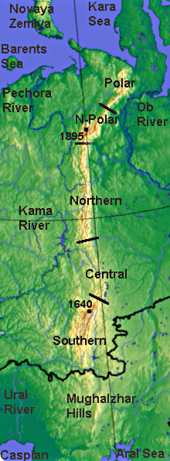
As Arab merchants traded with the 바시키르인(Bashkirs) and other people living on the western slopes of the Urals as far north as Great Perm(Great Perm), since at least the 10th century medieval Arab geographers(Arab geographers) had been aware of the existence of the mountain range in its entirety, stretching as far as to the Arctic Ocean in the north. The first Russian mention of the mountains to the east of the East European Plain is provided by the 원초 연대기(Primary Chronicle), when it describes the Novgorodian]](Novgorodian) expedition to the upper reaches of the 페초라(Pechora) in 1096. During the next few centuries Novgorodians engaged in fur trading(fur trading) with the local population and collected tribute from Yugra(Yugra) and Great Perm, slowly expanding southwards. The rivers Chusovaya]](Chusovaya) and Belaya]](Belaya) were first mentioned in the chronicles of 1396 and 1468, respectively. In 1430 the town of Solikamsk(Solikamsk) (Kama Salt) was founded on the Kama]](Kama) at the foothills of the Urals, where 소금(salt) was produced in open pans]](produced in open pans). Ivan III of Moscow(Ivan III of Moscow) captured Perm, Pechora and Yugra from the declining Novgorod Republic in 1472. With the excursions of 1483 and 1499-1500 across the Urals Moscow managed to subjugate Yugra completely.

Nevertheless, around that time early 16th century Polish geographer Maciej of Miechów(Maciej of Miechów) in his influential Tractatus de duabus Sarmatiis (1517) argued that there were no mountains in Eastern Europe at all, challenging the point of view of some authors of Classical antiquity, popular during the 르네상스(Renaissance). Only after Sigismund von Herberstein(Sigismund von Herberstein) in his Notes on Muscovite Affairs(Notes on Muscovite Affairs) (1549) had reported, following Russian sources, that there are mountains behind the Pechora and identified them with the Ripheans and Hyperboreans of ancient authors, did the existence of the Urals, or at least of its northern part, become firmly established in the 대항해 시대(Western geography). The Middle and Southern Urals were still largely unavailable and unknown to the Russian or Western European geographers.
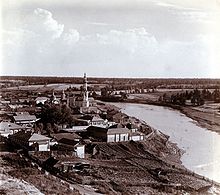
In the 1550s, after the 루스 차르국(Tsardom of Russia) had defeated the 카잔 한국(Khanate of Kazan) and proceeded to gradually annex the lands of the Bashkirs, the Russians finally reached the southern part of the mountain chain. In 1574 they founded 우파 (도시)(Ufa). The upper reaches of the Kama and Chusovaya in the Middle Urals, still unexplored, as well as parts of Transuralia still held by the hostile Siberian Khanate(Siberian Khanate), were granted to the Stroganovs(Stroganovs) by several decrees of the tsar in 1558-1574. The Stroganovs' land provided the staging ground for Yermak]](Yermak)'s incursion into Siberia]](incursion into Siberia). Yermak crossed the Urals from the Chusovaya to the Tagil]](Tagil) around 1581. In 1597 Babinov's road was built across the Urals from Solikamsk to the valley of the 투라(Tura), where the town of Verkhoturye(Verkhoturye) (Upper Tura) was founded in 1598. Customs was established in Verkhoturye shortly thereafter and the road was made the only legal connection between European Russia and Siberia for a long time. In 1648 the town of 쿤구르(Kungur) was founded at the western foothills of the Middle Urals. During the 17th century the first deposits of 철(iron) and 구리]](copper) ores, 운모(mica), 보석(gemstone)s and other minerals were discovered in the Urals.
Iron and copper smelting(smelting) works]](works) emerged. They multiplied particularly quickly during the reign of Peter I of Russia(Peter I of Russia). In 1720-1722 he commissioned 바실리 타시셰프(Vasily Tatishchev) to oversee and develop the mining and smelting works in the Urals. Tatishchev proposed a new copper smelting factory in Yegoshikha(Yegoshikha), which would eventually become the core of the city of 페름(Perm) and a new iron smelting factory on the Iset]](Iset), which would become the largest in the world at the time of construction and give birth to the city of 예카테린부르크(Yekaterinburg). Both factories were actually founded by Tatishchev's successor, Georg Wilhelm de Gennin(Georg Wilhelm de Gennin), in 1723. Tatishchev returned to the Urals on the order of Empress Anna]](Empress Anna) to succeed de Gennin in 1734-1737. Transportation of the output of the smelting works to the markets of European Russia necessitated the construction of the Siberian Route(Siberian Route) from Yekaterinburg across the Urals to Kungur and Yegoshikha (Perm) and further to Moscow, which was completed in 1763 and rendered Babinov's road obsolete. In 1745 gold was discovered in the Urals at Beryozovskoye]](Beryozovskoye) and later at other deposits. It has been mined since 1747.
The first railway across the Urals had been built by 1878 and linked Perm to Yekaterinburg via Chusovoy(Chusovoy), 쿠시바(Kushva) and 니즈니타길(Nizhny Tagil). In 1890 a railway linked Ufa and 첼랴빈스크(Chelyabinsk) via Zlatoust(Zlatoust). In 1896 this section became a part of the 시베리아 횡단 철도(Trans-Siberian Railway). In 1909 yet another railway connecting Perm and Yekaterinburg passed through 쿤구르(Kungur) by the way of the Siberian Route. It has eventually replaced the Ufa – Chelyabinsk section as the main trunk of the Trans-Siberian railway.
The highest peak of the Urals, Mount Narodnaya(Mount Narodnaya), was discovered in 1927.
During the Soviet industrialization(Soviet industrialization) in the 1930s the city of 마그니토고르스크(Magnitogorsk) was founded in the southeastern Urals as a center of iron smelting and steelmaking(steelmaking). During the German invasion of the Soviet Union]](German invasion of the Soviet Union) in 1941-1942, faced with the threat of having a significant part of the Soviet territories occupied by the enemy, the gorvernment evacuated many of the industrial enterprises of European Russia and Ukraine to the eastern foothills of the Urals, considered a safe place out of reach of the German bombers and troops. Three giant tank factories]](tank factories) were established at the Uralmash(Uralmash) in Sverdlovsk (as Yekaterinburg used to be known), Uralvagonzavod(Uralvagonzavod) in Nizhny Tagil, and Chelyabinsk Tractor Plant(Chelyabinsk Tractor Plant) in Chelyabinsk. After the war, in 1947-1948, Chum – Labytnangi(Labytnangi) railway, built with the forced labor of 굴락(Gulag) inmates, crossed the Polar Urals]](crossed the Polar Urals).
The first ample geographic survey of the Ural Mountains was completed in the early 18th century by the Russian historian and geographer 바실리 타시셰프(Vasily Tatishchev) under the orders of Peter I]](Peter I). Earlier, in the 17th century, rich ore deposits were discovered in the mountains and their systematic extraction began in the early 18th century, eventually turning the region into the largest mineral base of Russia.[1][5]
One of the first scientific descriptions of the mountains was published in 1770–71. Over the next century, the region was studied by scientists from a number of countries, including Russia (geologist Alexander Karpinsky(Alexander Karpinsky), botanist P.N. Krylov and zoologist L.P. Sabaneev), England (geologist Sir Roderick Murchison(Roderick Murchison)), France (paleontologist Edouard de Verneuil(Edouard de Verneuil)), and Germany (naturalist 알렉산더 폰 훔볼트(Alexander von Humboldt), geologist Alexander Keyserling(Alexander Keyserling)).[1][8] In 1845, Murchison, who had according to 브리태니커 백과사전(Encyclopædia Britannica) "compiled the first geologic map of the Urals in 1841",[1] published The Geology of Russia in Europe and the Ural Mountains with de Verneuil and Keyserling.[8][9]
Geography and topography[편집]
The Ural Mountains extend about 2,500 km (1,550 mi) from the 카라 해(Kara Sea) to the Kazakh steppes(Kazakh steppes) along the northern border of 카자흐스탄(Kazakhstan). 바이가치 섬(Vaygach Island) and the island of 노바야제믈랴 제도(Novaya Zemlya) form a further continuation of the chain on the north. Geographically this range marks the northern part of the border between the continents of Europe and Asia. Its highest peak is Mount Narodnaya(Mount Narodnaya) (1,895 m or 6,213 ft).[1]
By topography and other natural features, Ural is divided, from north to south, into the Polar (or Arctic), Nether-Polar (or Sub-Arctic), Northern, Central and Southern parts. The Polar Ural extends for about 385 kilometers (240 miles) from the Mount Konstantinov Kamen in the north to the Khulga River in the south; it has an area of about 25,000 km² and a strongly dissected relief. The maximum height is 1,499 meters (4,915 feet) at the Payer Mountain and the average height is 1,000–1,100 meters (3,280–3,605 feet). The mountains of Polar Ural could have sharp ridges but there are also flattened or rounded tops.[1][5]
The Nether-Polar Ural is wider (up to 150 km) and higher than the Polar Ural, with the highest peaks of 1,895 m (6,213 feet, Mount Narodnaya(Mount Narodnaya)), 1,878 m (6,157 feet, Mount Karpinsky (Urals)(Mount Karpinsky (Urals))) and 1,662 m (5,450 feet, Manaraga(Manaraga)). It extends for more than 225 kilometers (140 miles) south to the Shchugor River. Its many ridges have sawtooth shape and are dissected by river valleys. Both Polar and Nether-Polar Urals are typically Alpine; they bear traces of 플라이스토세(Pleistocene) glaciation and permafrost and have a rather developed modern glaciation that includes 143 glaciers.[1][5]
The Northern Ural consists of a series of parallel ridges with the height up to 1,000–1,200 m and longitudinal depressions. They are elongated from north to south and stretch for about 560 km (340 miles) from the Usa River. Most of the tops are flattened, but those of the highest mountains, such as Telposiz (1,617 m or 5,300 ft) and Konzhakovsky Stone (1,569 m or 5,144 ft) have dissected topography. Intensive weathering has produced vast areas of eroded stones on the mountain slopes and summits of the northern areas.[1][5]
The Central Ural is the lowest part of Urals, with the highest mountain of 994 m (Basegi) and smooth mountain tops; it extends south from the 우파 강(Ufa River).[5]
The relief of Southern Ural is more complex, with numerous valleys and parallel ridges directed south-west and meridionally. Its maximum height is 1,640 m (5,377 ft, Mount Yamantau(Mount Yamantau)) and the widths reaches 250 km. The Southern Ural extends some 550 km (340 mi) up to the sharp westward bend of the 우랄 강(Ural River) and terminates in the wide Mughalzhar Hills(Mughalzhar Hills).[1]
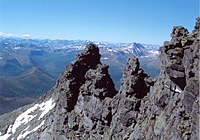
|

|

|

|
| Mountain formation near Saranpaul, Nether-Polar Urals | Rocks in a river, Nether-Polar Urals | Mountain Big Iremel | Entry to the Ignateva Cave, South Urals |
Geology[편집]
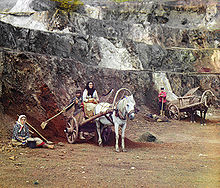
(mine) in the Ural Mountains, 1910.]]
The Urals are among the world's oldest extant mountain ranges(mountain ranges). For its age of 250 to 300 million years, the elevation of the mountains is unusually high. They were formed during the Uralian orogeny(Uralian orogeny) due to the collision]](collision) of the eastern edge of the supercontinent Laurussia(Laurussia) with the young and rheologically weak continent of Kazakhstania(Kazakhstania), which now underlies much of Kazakhstan and West Siberia west of the Irtysh(Irtysh), and intervening 열도(island arc)s. The collision lasted nearly 90 million years in the late 석탄기(Carboniferous) - early 트라이아스기(Triassic).[10][11][12][13] Unlike the other major orogens of the 고생대(Paleozoic) (Appalachians(Appalachians), Caledonides(Caledonides), Variscides(Variscides)), the Urals have not undergone post-orogenic extensional collapse]](post-orogenic extensional collapse) and are unusually well preserved for their age, being underlied by a pronounced crustal root.[14][15] East and south of the Urals much of the orogen is buried beneath later 중생대(Mesozoic) and 신생대(Cenozoic) sediment(sediment)s.[10] The adjacent Pay-Khoy to the north is not a part of the Uralian orogen and formed later.
Many deformed and metamorphosed rocks, mostly of Paleozoic period, surface within the Urals. The sedimentary and volcanic layers are folded and broken, and form meridional bands. The sediments to the west of the Ural Mountains are formed by 석회암(limestone), 백운암 (암석)(dolomite) and 사암(sandstone) left from ancient shallow seas. The eastern side is dominated by basalts similar to the rocks of the bottom of the modern oceans.[5]
The western slope of the Ural Mountains has predominantly 카르스트 지형(karst topography), especially in the basin of the Sylva River(Sylva River), which is a tributary of the Chusovaya River(Chusovaya River). It is composed of severely eroded sedimentary rocks (sandstones and limestones) that are about 350 million years old. There are many caves, karst sinks and underground streams. The karst topography is much less developed on the eastern slopes. They are relatively flat, with some hills and rocky outcrops and contain alternating volcanic and sedimentary layers dated to the middle Paleozoic period.[5] Most high mountains consist of weather-resistant minerals such as 규암(quartzite), 결정편암(schist) and 반려암(gabbro) that are between 570 and 395 million years old. The river valleys are laid with limestone.[1]
Ural Mountains contain about 48 species of economically valuable ores and minerals. Eastern regions are rich in chalcopyrite(chalcopyrite), nickel oxide(nickel oxide), 금(gold), 백금(platinum), chromite(chromite) and 자철석(magnetite) ores, as well as in coal (첼랴빈스크 주(Chelyabinsk Oblast)), 보크사이트(bauxite), talc, fireclay and abrasives. Western Ural contains deposits of coal, oil, natural gas (Ishimbay and Krasnokamsk areas) and 칼륨(potassium) salts. Both slopes are rich in bituminous coal and 갈탄(lignite), and the largest deposit of bituminous coal is in the north (Pechora field). The specialty of Urals is precious and semi-precious stones, such as 에메랄드(emerald), amethyst(amethyst), aquamarine(aquamarine), jasper(jasper), rhodonite(rhodonite), 공작석(malachite) and 다이아몬드(diamond). Some of the deposits, such as the magnetite ores at Magnitogorsk are already nearly depleted.[1][5]
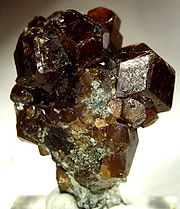
|
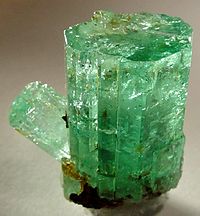
|
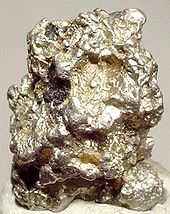
|
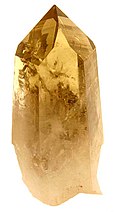
|
| Andradite(Andradite) | Beryl(Beryl) | 백금(Platinum) | 석영(Quartz) |
Rivers and lakes[편집]

Many rivers originate in the Ural Mountains. The Western slope south of the border between the Komi Republic and Perm Krai and Eastern slope south of approximately 54º30'N drain into the 카스피 해(Caspian Sea) via the Kama]](Kama) and 우랄(Ural) river basins. The tributaries of the Kama include the Vishera]](Vishera), Chusovaya]](Chusovaya), and Belaya]](Belaya) and originate both in the eastern and western slopes. The rest of the Urals drains into the 북극해(Arctic Ocean), mainly via the 페초라(Pechora) basin in the west, which includes the Ilych]](Ilych), Shchugor, and Usa]](Usa), and via the Ob]](Ob) basin in the east, which includes the Tobol]](Tobol), Tavda]](Tavda), Iset]](Iset), 투라(Tura) and Severnaya Sosva]](Severnaya Sosva). The rivers freeze for more than half a year. Generally, the western rivers are more affluent than the eastern ones, especially in the Northern and Nether-Polar regions. Rivers are slower in the Southern Ural. This is because of low precipitation and relatively warm climate resulting in less snow and more evaporation.[1][5]
The mountains are home to a number of deep lakes.[16] The eastern slope of the Southern and Central Urals, which hosts among its largest lakes the Uvildy, Itkul, Turgoyak, and Tavatuy, is home to most of these.[5] Less numerous, the lakes found on the western slope are also smaller. Lake Bolshoye Shchuchye, the deepest lake in the Polar Urals, is 틀:M to ft deep. Other lakes, too, are found in this region, in its glacial valleys. Spas and sanatoriums have been built to take advantage of the medicinal muds found in some of the lakes in the mountains.[1][5]
Climate[편집]
The climate of Urals is continental. The mountain ridges elongated from north to south, effectively absorb sunlight thereby increasing the temperature. The areas west to the Ural Mountains are 1–2 °C warmer in winter than the eastern regions because the former are warmed by the Atlantic winds whereas the eastern slopes are chilled by the Siberian air masses. The average January temperatures increase in the western areas from –20 °C in the Polar to –15 °C in the Southern Urals and the corresponding temperatures in July are 10 °C and 20 °C. The western areas also received more rainfall than the eastern ones by 150–300 mm per year. This is because the mountains trap the clouds brought from the Atlantic Ocean. The highest precipitation (1000 mm) is in the Northern Ural that causes the average height of snow up to 100 cm (3.3 ft). The eastern parts receive from 500–600 mm on the north to 300–400 mm on the south. Maximum precipitation occurs in the summer and the winter is dry because of the 시베리아 기단(Siberian High).[1][5]
Flora[편집]
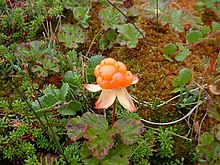
The landscapes of Urals change both in the latitudinal and vertical directions and are dominated by forests and steppes. The southern area of the Mughalzhar Hills is a semidesert. Steppes lie mostly in the southern and especially south-eastern Urals. Meadow steppes have developed in the lower parts of mountain slopes and are covered with 지그재그]](zigzag) and mountain clover]](mountain clover)s, Serratula(Serratula) gmelinii, dropwort(dropwort), meadow-grass]](meadow-grass) and Bromus inermis(Bromus inermis), reaching the height of 60–80 cm. Many lands are cultivated. Moving to the south, the meadow steppes become more sparse, dry and low. The steep gravelly slopes of mountains and hills of eastern slopes of the Southern Ural are mostly covered with rocky steppes. Valleys of the rivers contain 버드나무속(willow), poplar(poplar) and caragana(caragana) shrubs.[5]
Forest landscapes of Urals are diverse, especially the southern part. The western areas are dominated by dark coniferous taiga forests which change to mixed and deciduous forests on the south. The eastern mountain slopes have light coniferous taiga forests. The Northern Ural is dominated by conifers, namely Siberian fir(Siberian fir), Siberian pine(Siberian pine), Scots pine(Scots pine), Siberian spruce(Siberian spruce), Norway spruce(Norway spruce) and Siberian larch(Siberian larch), as well as by 은]](Silver) and downy birch(downy birch)es. Forests are much more sparse in Polar Ural. Whereas in other Ural Mountains areas they grow up to the heights of 1 km, the tree line(tree line) is at 250–400 m in the Polar Urals. The polar forests are low and are mixed with swamps, lichens, bogs and shrubs. Abundant are dwarf birch]](dwarf birch), mosses and berries (블루베리(blueberry), cloudberry]](cloudberry), black crowberry]](black crowberry), etc.). Southern Ural is most diverse in the forest composition; here together with coniferous forests also abundant are brodleaf tree species such as English oak(English oak), Norway maple(Norway maple) and elm.[5] The 코미 원시림(Virgin Komi Forests) in the northern Urals are recognized as a World Heritage(World Heritage) site.
Fauna[편집]
Ural forests are inhabited by animals typical of Siberia, such as elk, brown bear, fox, wolf, wolverine(wolverine), 스라소니속(lynx), squirrel and 검은담비(sable) (north only). Because of the easy accessibility of the mountains there are no specifically mountanous species. In the Middle Ural, one can meet a rare mixture of sable and pine marten named kidus. In the Southern Ural, frequent are 오소리아과(badger) and black polecat]](black polecat). Reptiles and amphibians live mostly in the Southern and Central Ural and are represented by the common viper(common viper), lizards and grass snake]](grass snake)s. Bird species are represented by capercaillie]](capercaillie), black grouse(black grouse), hazel grouse(hazel grouse), Spotted Nutcracker(Spotted Nutcracker) and cuckoos. In summers, South and Middle Urals are visited by songbirds, such as 나이팅게일(nightingale) and redstart(redstart).[1][5]
Steppes of the Southern Urals are dominated by hares and rodents such as gophers]](gophers), susliks]](susliks) and jerboa(jerboa). There are many birds of prey such as Lesser Kestrel(Lesser Kestrel) and buzzard(buzzard)s. The animals of the Polar Ural are few and are characteristic of the 툰드라(tundra) and include Arctic Fox(Arctic Fox), tundra partridge, 레밍(lemming) and reindeer. The birds of those areas include rough-legged buzzard(rough-legged buzzard), Snowy Owl(Snowy Owl) and Rock Ptarmigan(Rock Ptarmigan).[1][5]

|

|

|
| Gopher(Gopher) | Wolverine(Wolverine) | Polecat(Polecat) |
Ecology[편집]
The continuous and intensive economic development of the last centuries has affected the fauna, and the wildlife is very much reduced around all industrial centers. During World War II, hundreds of factories were evacuated from the Western Russia right before the German occupation, flooding the Urals with industry. The conservation measures include establishing national wildlife parks.[1] There are nine strict nature reserves]](strict nature reserves) in the Urals: the Ilmen]](Ilmen), the oldest one, mineralogical reserve founded in 1920 in Chelyabinsk Oblast, Pechora-Ilych]](Pechora-Ilych) in the Komi Republic, Bashkir]](Bashkir) and its former branch Shulgan-Tash]](Shulgan-Tash) in Bashkortostan, Visim]](Visim) in Sverdlovsk Oblast, South Urals]](South Urals) in Bashkortostan, Basegi]](Basegi) in Perm Krai, Vishera]](Vishera) in Perm Krai and Denezhkin Kamen]](Denezhkin Kamen) in Sverdlovsk Oblast.
The area has also been severely damaged by the 플루토늄(plutonium)-producing facility Mayak(Mayak) opened in Chelyabinsk-40 (later called Chelyabinsk-65, 오조르스크(Ozyorsk)), in the Southern Urals, after World War II.[1] Its plants went into operation in 1948 and, for the first ten years of their existence, dumped unfiltered radioactive waste into the Techa River(Techa River) and Lake Karachay(Lake Karachay).[1][17][18] In 1990, efforts were underway to contain the radiation in one of the lakes, which was estimated at the time to expose visitors to 500 millirem]](millirem) per day.[18] As of 2006, 500 mrem in the natural environment was the upper limit of exposure considered safe for a member of the general public in an entire year (though workplace exposure over a year could exceed that by a factor of 10).[19] 틀:Mi2 to km2 of land were contaminated in 1957 from a storage tank explosion, only one of several serious accidents that further polluted the region.[1] The 1957 accident]](1957 accident) expelled 20 million curies(curies) of radioactive material, 90% of which settled into the land immediately around the facility.[20] Although some reactors of Mayak were shut down in 1987 and 1990,[18] the facility keeps producing plutonium.[21]
See also[편집]
- Dyatlov Pass incident(Dyatlov Pass incident)
- Idel-Ural State(Idel-Ural State)
- 판게아(Pangaea)
- 우랄 지역(Ural (region))
References[편집]
- ↑ 가 나 다 라 마 바 사 아 자 차 카 타 파 하 거 너 더 러 머 버 Ural Mountains, Encyclopædia Britannica on-line
- ↑ Noah Webster (1823). 《Letters to a young gentleman commencing his education: to which is subjoined a brief history of the United States》. Howe & Spalding, S. Converse. 101쪽.
- ↑ Siegmund Jakob Baumgarten, Ferdinand Wilhelm Beer, Johann Salomo Semler (1760). 《A supplement to the English Universal history: lately published in London: containing ... remarks and annotations on the Universal history, designed as an improvement and illustration of that work》. E. Dilly. 145쪽.
- ↑ Фасмер, Макс]](Фасмер, Макс). Этимологический словарь русского языка
- ↑ 가 나 다 라 마 바 사 아 자 차 카 타 파 하 거 너 더 “Ural (geographical)”. 소비에트 대백과사전(Great Soviet Encyclopedia).
- ↑ *Ludmila Koriakova and Andrei Epimakhov (2007). 《The Urals and Western Siberia in the Bronze and Iron Ages》. Cambridge University Press. 338쪽. ISBN 0521829283.
- ↑ Ural, toponym Chlyabinsk Encyclopedia (in Russian)
- ↑ 가 나 Geological Society of London (1894). 《The Quarterly journal of the Geological Society of London》. The Society. 53쪽. 2010년 7월 8일에 확인함.
- ↑ cf. Murchison, Roderick Impey; Edouard de Verneuil(Edouard de Verneuil); Alexander Keyserling(Alexander Keyserling) (1845). 《The Geology of Russia in Europe and the Ural Mountains》. John Murray. 2010년 7월 8일에 확인함.
- ↑ 가 나 D. Brown & H. Echtler. The Urals. In: R. C. Selley, L. R. M. Cocks & I. R. Plimer (eds.), Encyclopedia of Geology, Vol. 2. Elsevier, 2005. P 86-95.
- ↑ L. R. M. Cocks & T. H. Torsvik. European geography in a global context from the Vendian to the end of the Palaeozoic. In Gee, D. G. & Stephenson, R. A. (eds), European Lithosphere Dynamics. Geological Society, London, Memoirs, 32, 83–95.
- ↑ Victor N. Puchkov. The evolution of the Uralian orogen. Geological Society, London, Special Publications, 2009; v. 327; p. 161-195.
- ↑ D. Brown et al. Mountain building processes during continent–continent collision in the Uralides. Earth-Science Reviews, Volume 89, Issues 3-4, August 2008, Pages 177-195.
- ↑ Mary L. Leech. Arrested orogenic development: eclogitization, delamination, and tectonic collapse. Earth and Planetary Science Letters 185 (2001) 149-159.
- ↑ Jane H. Scarrow, Conxi Ayala & Geoffrey S. Kimbell. Insights into orogenesis: getting to the root of a continent–ocean–continent collision, Southern Urals, Russia. Journal of the Geological Society, London, Vol. 159, 2002, pp. 659–671.
- ↑ Davis, W.M. (1898). 〈The Ural Mountains〉. American Association for the Advancement of Science(American Association for the Advancement of Science). 《Science》. Moses King. 563쪽. 2010년 7월 8일에 확인함.
- ↑ Podvig, Pavel; Oleg Bukharin; Frank von Hippel (2004년 3월 1일). 《Russian Strategic Nuclear Forces》. MIT Press. 70쪽. ISBN 9780262661812. 2010년 7월 8일에 확인함.
- ↑ 가 나 다 Paine, Christopher (1989년 7월 22일). “Military reactors go on show to American visitors”. 《New Scientist(New Scientist)》. 2010년 7월 8일에 확인함.
- ↑ American Chemical Society (2006년 1월 31일). 《Chemistry in the Community: ChemCom》. Macmillan. 499쪽. ISBN 9780716789192. 2010년 7월 8일에 확인함.
- ↑ Educational Foundation for Nuclear Science, Inc. (May 1991). 《Bulletin of the Atomic Scientists》. Educational Foundation for Nuclear Science, Inc. 25쪽. ISSN 00963402. 2010년 7월 8일에 확인함.
- ↑ Plutonium production will not be transferred from Mayak, 25 March 2010 (in Russian)
External links[편집]
- 틀:Wikitravelpar
- Peakbagger.com page on the Ural Mountains
- Ural Expeditions & Tours page on the five parts of the Ural Mountains
틀:Geography topics 틀:Physical geography topics 틀:Russia topics
영한병기판[편집]
| The Ural Mountains | |
| Range | |
| 나라 | Russia · Kazakhstan |
|---|---|
| 최고점 | Mount Narodnaya(Mount Narodnaya) |
| - 높이 | 1,895 m (6,217 ft) |
| 길이 | 2,500 km (1,553 mi) |
| 폭 | 40−150 km (−53 mi) |
| 지질 시대 | Carboniferous |
The Ural Mountains (러시아어: Ура́льские го́ры, Uralskiye gory) are a mountain range that runs approximately from north to south through western Russia(western Russia), from the coast of the Arctic Ocean(북극해) to the Ural River(우랄 강) and northwestern Kazakhstan(카자흐스탄).[1] Their eastern side is usually considered the natural boundary between Europe and Asia. The mountains lie within the Ural(우랄) geographical region and significantly overlap with the Ural Federal District(우랄 연방관구) and Ural economic region(Ural economic region). They are rich in various deposits, including metal ores, coal, precious and semi-precious stones, and since the 18th century have been the major mineral base of Russia.
Etymology[편집]
In Greco-Roman antiquity(고전 고대), Pliny the Elder(대 플리니우스) thought that the Urals correspond to the Riphean Mountains(Riphean Mountains)[2][3] mentioned by various authors, including Arabic sources of the 10th century. As attested by Sigismund von Herberstein(Sigismund von Herberstein), in the 16th century Russians called the range by a variety of names derived from the Russian words for rock (stone) and belt. The modern Russian name for the Urals (Урал, Ural), which first appeared in the 16th-17th century, was initially applied to its southern parts and gained currency as the name of the entire range during the 18th century. It might be a borrowing from either Turkic(Turkic]]) (Bashkir(Bashkir]]), where the same name is used for the range), or Ob-Ugric(Ob-Ugric]]).[4] From the 13th century, in Bashkortostan(바시키르 공화국) there has been a legend about a hero named Ural(legend about a hero named Ural]]). He sacrificed his life for the sake of his people and they poured a stone pile over his grave which later turned into the Ural Mountains.[5][6][7]
History[편집]

As Arab merchants traded with the Bashkirs(바시키르인) and other people living on the western slopes of the Urals as far north as Great Perm(Great Perm), since at least the 10th century medieval Arab geographers(Arab geographers) had been aware of the existence of the mountain range in its entirety, stretching as far as to the Arctic Ocean in the north. The first Russian mention of the mountains to the east of the East European Plain is provided by the Primary Chronicle(원초 연대기), when it describes the Novgorodian(Novgorodian]]) expedition to the upper reaches of the Pechora(페초라) in 1096. During the next few centuries Novgorodians engaged in fur trading(fur trading) with the local population and collected tribute from Yugra(Yugra) and Great Perm, slowly expanding southwards. The rivers Chusovaya(Chusovaya]]) and Belaya(Belaya]]) were first mentioned in the chronicles of 1396 and 1468, respectively. In 1430 the town of Solikamsk(Solikamsk) (Kama Salt) was founded on the Kama(Kama]]) at the foothills of the Urals, where salt(소금) was produced in open pans(produced in open pans]]). Ivan III of Moscow(Ivan III of Moscow) captured Perm, Pechora and Yugra from the declining Novgorod Republic in 1472. With the excursions of 1483 and 1499-1500 across the Urals Moscow managed to subjugate Yugra completely.

Nevertheless, around that time early 16th century Polish geographer Maciej of Miechów(Maciej of Miechów) in his influential Tractatus de duabus Sarmatiis (1517) argued that there were no mountains in Eastern Europe at all, challenging the point of view of some authors of Classical antiquity, popular during the Renaissance(르네상스). Only after Sigismund von Herberstein(Sigismund von Herberstein) in his Notes on Muscovite Affairs(Notes on Muscovite Affairs) (1549) had reported, following Russian sources, that there are mountains behind the Pechora and identified them with the Ripheans and Hyperboreans of ancient authors, did the existence of the Urals, or at least of its northern part, become firmly established in the Western geography(대항해 시대). The Middle and Southern Urals were still largely unavailable and unknown to the Russian or Western European geographers.

In the 1550s, after the Tsardom of Russia(루스 차르국) had defeated the Khanate of Kazan(카잔 한국) and proceeded to gradually annex the lands of the Bashkirs, the Russians finally reached the southern part of the mountain chain. In 1574 they founded Ufa(우파 (도시)). The upper reaches of the Kama and Chusovaya in the Middle Urals, still unexplored, as well as parts of Transuralia still held by the hostile Siberian Khanate(Siberian Khanate), were granted to the Stroganovs(Stroganovs) by several decrees of the tsar in 1558-1574. The Stroganovs' land provided the staging ground for Yermak(Yermak]])'s incursion into Siberia(incursion into Siberia]]). Yermak crossed the Urals from the Chusovaya to the Tagil(Tagil]]) around 1581. In 1597 Babinov's road was built across the Urals from Solikamsk to the valley of the Tura(투라), where the town of Verkhoturye(Verkhoturye) (Upper Tura) was founded in 1598. Customs was established in Verkhoturye shortly thereafter and the road was made the only legal connection between European Russia and Siberia for a long time. In 1648 the town of Kungur(쿤구르) was founded at the western foothills of the Middle Urals. During the 17th century the first deposits of iron(철) and copper(구리]]) ores, mica(운모), gemstone(보석)s and other minerals were discovered in the Urals.
Iron and copper smelting(smelting) works(works]]) emerged. They multiplied particularly quickly during the reign of Peter I of Russia(Peter I of Russia). In 1720-1722 he commissioned Vasily Tatishchev(바실리 타시셰프) to oversee and develop the mining and smelting works in the Urals. Tatishchev proposed a new copper smelting factory in Yegoshikha(Yegoshikha), which would eventually become the core of the city of Perm(페름) and a new iron smelting factory on the Iset(Iset]]), which would become the largest in the world at the time of construction and give birth to the city of Yekaterinburg(예카테린부르크). Both factories were actually founded by Tatishchev's successor, Georg Wilhelm de Gennin(Georg Wilhelm de Gennin), in 1723. Tatishchev returned to the Urals on the order of Empress Anna(Empress Anna]]) to succeed de Gennin in 1734-1737. Transportation of the output of the smelting works to the markets of European Russia necessitated the construction of the Siberian Route(Siberian Route) from Yekaterinburg across the Urals to Kungur and Yegoshikha (Perm) and further to Moscow, which was completed in 1763 and rendered Babinov's road obsolete. In 1745 gold was discovered in the Urals at Beryozovskoye(Beryozovskoye]]) and later at other deposits. It has been mined since 1747.
The first railway across the Urals had been built by 1878 and linked Perm to Yekaterinburg via Chusovoy(Chusovoy), Kushva(쿠시바) and Nizhny Tagil(니즈니타길). In 1890 a railway linked Ufa and Chelyabinsk(첼랴빈스크) via Zlatoust(Zlatoust). In 1896 this section became a part of the Trans-Siberian Railway(시베리아 횡단 철도). In 1909 yet another railway connecting Perm and Yekaterinburg passed through Kungur(쿤구르) by the way of the Siberian Route. It has eventually replaced the Ufa – Chelyabinsk section as the main trunk of the Trans-Siberian railway.
The highest peak of the Urals, Mount Narodnaya(Mount Narodnaya), was discovered in 1927.
During the Soviet industrialization(Soviet industrialization) in the 1930s the city of Magnitogorsk(마그니토고르스크) was founded in the southeastern Urals as a center of iron smelting and steelmaking(steelmaking). During the German invasion of the Soviet Union(German invasion of the Soviet Union]]) in 1941-1942, faced with the threat of having a significant part of the Soviet territories occupied by the enemy, the gorvernment evacuated many of the industrial enterprises of European Russia and Ukraine to the eastern foothills of the Urals, considered a safe place out of reach of the German bombers and troops. Three giant tank factories(tank factories]]) were established at the Uralmash(Uralmash) in Sverdlovsk (as Yekaterinburg used to be known), Uralvagonzavod(Uralvagonzavod) in Nizhny Tagil, and Chelyabinsk Tractor Plant(Chelyabinsk Tractor Plant) in Chelyabinsk. After the war, in 1947-1948, Chum – Labytnangi(Labytnangi) railway, built with the forced labor of Gulag(굴락) inmates, crossed the Polar Urals(crossed the Polar Urals]]).
The first ample geographic survey of the Ural Mountains was completed in the early 18th century by the Russian historian and geographer Vasily Tatishchev(바실리 타시셰프) under the orders of Peter I(Peter I]]). Earlier, in the 17th century, rich ore deposits were discovered in the mountains and their systematic extraction began in the early 18th century, eventually turning the region into the largest mineral base of Russia.[1][5]
One of the first scientific descriptions of the mountains was published in 1770–71. Over the next century, the region was studied by scientists from a number of countries, including Russia (geologist Alexander Karpinsky(Alexander Karpinsky), botanist P.N. Krylov and zoologist L.P. Sabaneev), England (geologist Sir Roderick Murchison(Roderick Murchison)), France (paleontologist Edouard de Verneuil(Edouard de Verneuil)), and Germany (naturalist Alexander von Humboldt(알렉산더 폰 훔볼트), geologist Alexander Keyserling(Alexander Keyserling)).[1][8] In 1845, Murchison, who had according to Encyclopædia Britannica(브리태니커 백과사전) "compiled the first geologic map of the Urals in 1841",[1] published The Geology of Russia in Europe and the Ural Mountains with de Verneuil and Keyserling.[8][9]
Geography and topography[편집]
The Ural Mountains extend about 2,500 km (1,550 mi) from the Kara Sea(카라 해) to the Kazakh steppes(Kazakh steppes]]) along the northern border of Kazakhstan(카자흐스탄). Vaygach Island(바이가치 섬) and the island of Novaya Zemlya(노바야제믈랴 제도) form a further continuation of the chain on the north. Geographically this range marks the northern part of the border between the continents of Europe and Asia. Its highest peak is Mount Narodnaya(Mount Narodnaya) (1,895 m or 6,213 ft).[1]
By topography and other natural features, Ural is divided, from north to south, into the Polar (or Arctic), Nether-Polar (or Sub-Arctic), Northern, Central and Southern parts. The Polar Ural extends for about 385 kilometers (240 miles) from the Mount Konstantinov Kamen in the north to the Khulga River in the south; it has an area of about 25,000 km² and a strongly dissected relief. The maximum height is 1,499 meters (4,915 feet) at the Payer Mountain and the average height is 1,000–1,100 meters (3,280–3,605 feet). The mountains of Polar Ural could have sharp ridges but there are also flattened or rounded tops.[1][5]
The Nether-Polar Ural is wider (up to 150 km) and higher than the Polar Ural, with the highest peaks of 1,895 m (6,213 feet, Mount Narodnaya(Mount Narodnaya)), 1,878 m (6,157 feet, Mount Karpinsky (Urals)(Mount Karpinsky (Urals))) and 1,662 m (5,450 feet, Manaraga(Manaraga)). It extends for more than 225 kilometers (140 miles) south to the Shchugor River. Its many ridges have sawtooth shape and are dissected by river valleys. Both Polar and Nether-Polar Urals are typically Alpine; they bear traces of Pleistocene(플라이스토세) glaciation and permafrost and have a rather developed modern glaciation that includes 143 glaciers.[1][5]
The Northern Ural consists of a series of parallel ridges with the height up to 1,000–1,200 m and longitudinal depressions. They are elongated from north to south and stretch for about 560 km (340 miles) from the Usa River. Most of the tops are flattened, but those of the highest mountains, such as Telposiz (1,617 m or 5,300 ft) and Konzhakovsky Stone (1,569 m or 5,144 ft) have dissected topography. Intensive weathering has produced vast areas of eroded stones on the mountain slopes and summits of the northern areas.[1][5]
The Central Ural is the lowest part of Urals, with the highest mountain of 994 m (Basegi) and smooth mountain tops; it extends south from the Ufa River(우파 강).[5]
The relief of Southern Ural is more complex, with numerous valleys and parallel ridges directed south-west and meridionally. Its maximum height is 1,640 m (5,377 ft, Mount Yamantau(Mount Yamantau)) and the widths reaches 250 km. The Southern Ural extends some 550 km (340 mi) up to the sharp westward bend of the Ural River(우랄 강) and terminates in the wide Mughalzhar Hills(Mughalzhar Hills).[1]

|

|

|

|
| Mountain formation near Saranpaul, Nether-Polar Urals | Rocks in a river, Nether-Polar Urals | Mountain Big Iremel | Entry to the Ignateva Cave, South Urals |
Geology[편집]

) in the Ural Mountains, 1910.]]
The Urals are among the world's oldest extant mountain ranges(mountain ranges). For its age of 250 to 300 million years, the elevation of the mountains is unusually high. They were formed during the Uralian orogeny(Uralian orogeny) due to the collision(collision]]) of the eastern edge of the supercontinent Laurussia(Laurussia) with the young and rheologically weak continent of Kazakhstania(Kazakhstania), which now underlies much of Kazakhstan and West Siberia west of the Irtysh(Irtysh), and intervening island arc(열도)s. The collision lasted nearly 90 million years in the late Carboniferous(석탄기) - early Triassic(트라이아스기).[10][11][12][13] Unlike the other major orogens of the Paleozoic(고생대) (Appalachians(Appalachians), Caledonides(Caledonides), Variscides(Variscides)), the Urals have not undergone post-orogenic extensional collapse(post-orogenic extensional collapse]]) and are unusually well preserved for their age, being underlied by a pronounced crustal root.[14][15] East and south of the Urals much of the orogen is buried beneath later Mesozoic(중생대) and Cenozoic(신생대) sediment(sediment)s.[10] The adjacent Pay-Khoy to the north is not a part of the Uralian orogen and formed later.
Many deformed and metamorphosed rocks, mostly of Paleozoic period, surface within the Urals. The sedimentary and volcanic layers are folded and broken, and form meridional bands. The sediments to the west of the Ural Mountains are formed by limestone(석회암), dolomite(백운암 (암석)) and sandstone(사암) left from ancient shallow seas. The eastern side is dominated by basalts similar to the rocks of the bottom of the modern oceans.[5]
The western slope of the Ural Mountains has predominantly karst topography(카르스트 지형), especially in the basin of the Sylva River(Sylva River), which is a tributary of the Chusovaya River(Chusovaya River). It is composed of severely eroded sedimentary rocks (sandstones and limestones) that are about 350 million years old. There are many caves, karst sinks and underground streams. The karst topography is much less developed on the eastern slopes. They are relatively flat, with some hills and rocky outcrops and contain alternating volcanic and sedimentary layers dated to the middle Paleozoic period.[5] Most high mountains consist of weather-resistant minerals such as quartzite(규암), schist(결정편암) and gabbro(반려암) that are between 570 and 395 million years old. The river valleys are laid with limestone.[1]
Ural Mountains contain about 48 species of economically valuable ores and minerals. Eastern regions are rich in chalcopyrite(chalcopyrite), nickel oxide(nickel oxide), gold(금), platinum(백금), chromite(chromite) and magnetite(자철석) ores, as well as in coal (Chelyabinsk Oblast(첼랴빈스크 주)), bauxite(보크사이트), talc, fireclay and abrasives. Western Ural contains deposits of coal, oil, natural gas (Ishimbay and Krasnokamsk areas) and potassium(칼륨) salts. Both slopes are rich in bituminous coal and lignite(갈탄), and the largest deposit of bituminous coal is in the north (Pechora field). The specialty of Urals is precious and semi-precious stones, such as emerald(에메랄드), amethyst(amethyst), aquamarine(aquamarine), jasper(jasper), rhodonite(rhodonite), malachite(공작석) and diamond(다이아몬드). Some of the deposits, such as the magnetite ores at Magnitogorsk are already nearly depleted.[1][5]

|

|

|

|
| Andradite(Andradite) | Beryl(Beryl) | Platinum(백금) | Quartz(석영) |
Rivers and lakes[편집]

Many rivers originate in the Ural Mountains. The Western slope south of the border between the Komi Republic and Perm Krai and Eastern slope south of approximately 54º30'N drain into the Caspian Sea(카스피 해) via the Kama(Kama]]) and Ural(우랄) river basins. The tributaries of the Kama include the Vishera(Vishera]]), Chusovaya(Chusovaya]]), and Belaya(Belaya]]) and originate both in the eastern and western slopes. The rest of the Urals drains into the Arctic Ocean(북극해), mainly via the Pechora(페초라) basin in the west, which includes the Ilych(Ilych]]), Shchugor, and Usa(Usa]]), and via the Ob(Ob]]) basin in the east, which includes the Tobol(Tobol]]), Tavda(Tavda]]), Iset(Iset]]), Tura(투라) and Severnaya Sosva(Severnaya Sosva]]). The rivers freeze for more than half a year. Generally, the western rivers are more affluent than the eastern ones, especially in the Northern and Nether-Polar regions. Rivers are slower in the Southern Ural. This is because of low precipitation and relatively warm climate resulting in less snow and more evaporation.[1][5]
The mountains are home to a number of deep lakes.[16] The eastern slope of the Southern and Central Urals, which hosts among its largest lakes the Uvildy, Itkul, Turgoyak, and Tavatuy, is home to most of these.[5] Less numerous, the lakes found on the western slope are also smaller. Lake Bolshoye Shchuchye, the deepest lake in the Polar Urals, is 틀:M to ft deep. Other lakes, too, are found in this region, in its glacial valleys. Spas and sanatoriums have been built to take advantage of the medicinal muds found in some of the lakes in the mountains.[1][5]
Climate[편집]
The climate of Urals is continental. The mountain ridges elongated from north to south, effectively absorb sunlight thereby increasing the temperature. The areas west to the Ural Mountains are 1–2 °C warmer in winter than the eastern regions because the former are warmed by the Atlantic winds whereas the eastern slopes are chilled by the Siberian air masses. The average January temperatures increase in the western areas from –20 °C in the Polar to –15 °C in the Southern Urals and the corresponding temperatures in July are 10 °C and 20 °C. The western areas also received more rainfall than the eastern ones by 150–300 mm per year. This is because the mountains trap the clouds brought from the Atlantic Ocean. The highest precipitation (1000 mm) is in the Northern Ural that causes the average height of snow up to 100 cm (3.3 ft). The eastern parts receive from 500–600 mm on the north to 300–400 mm on the south. Maximum precipitation occurs in the summer and the winter is dry because of the Siberian High(시베리아 기단).[1][5]
Flora[편집]

The landscapes of Urals change both in the latitudinal and vertical directions and are dominated by forests and steppes. The southern area of the Mughalzhar Hills is a semidesert. Steppes lie mostly in the southern and especially south-eastern Urals. Meadow steppes have developed in the lower parts of mountain slopes and are covered with zigzag(지그재그]]) and mountain clover(mountain clover]])s, Serratula(Serratula) gmelinii, dropwort(dropwort), meadow-grass(meadow-grass]]) and Bromus inermis(Bromus inermis), reaching the height of 60–80 cm. Many lands are cultivated. Moving to the south, the meadow steppes become more sparse, dry and low. The steep gravelly slopes of mountains and hills of eastern slopes of the Southern Ural are mostly covered with rocky steppes. Valleys of the rivers contain willow(버드나무속), poplar(poplar) and caragana(caragana) shrubs.[5]
Forest landscapes of Urals are diverse, especially the southern part. The western areas are dominated by dark coniferous taiga forests which change to mixed and deciduous forests on the south. The eastern mountain slopes have light coniferous taiga forests. The Northern Ural is dominated by conifers, namely Siberian fir(Siberian fir), Siberian pine(Siberian pine), Scots pine(Scots pine), Siberian spruce(Siberian spruce), Norway spruce(Norway spruce) and Siberian larch(Siberian larch), as well as by Silver(은]]) and downy birch(downy birch)es. Forests are much more sparse in Polar Ural. Whereas in other Ural Mountains areas they grow up to the heights of 1 km, the tree line(tree line) is at 250–400 m in the Polar Urals. The polar forests are low and are mixed with swamps, lichens, bogs and shrubs. Abundant are dwarf birch(dwarf birch]]), mosses and berries (blueberry(블루베리), cloudberry(cloudberry]]), black crowberry(black crowberry]]), etc.). Southern Ural is most diverse in the forest composition; here together with coniferous forests also abundant are brodleaf tree species such as English oak(English oak), Norway maple(Norway maple) and elm.[5] The Virgin Komi Forests(코미 원시림) in the northern Urals are recognized as a World Heritage(World Heritage) site.
Fauna[편집]
Ural forests are inhabited by animals typical of Siberia, such as elk, brown bear, fox, wolf, wolverine(wolverine), lynx(스라소니속), squirrel and sable(검은담비) (north only). Because of the easy accessibility of the mountains there are no specifically mountanous species. In the Middle Ural, one can meet a rare mixture of sable and pine marten named kidus. In the Southern Ural, frequent are badger(오소리아과) and black polecat(black polecat]]). Reptiles and amphibians live mostly in the Southern and Central Ural and are represented by the common viper(common viper), lizards and grass snake(grass snake]])s. Bird species are represented by capercaillie(capercaillie]]), black grouse(black grouse), hazel grouse(hazel grouse), Spotted Nutcracker(Spotted Nutcracker) and cuckoos. In summers, South and Middle Urals are visited by songbirds, such as nightingale(나이팅게일) and redstart(redstart).[1][5]
Steppes of the Southern Urals are dominated by hares and rodents such as gophers(gophers]]), susliks(susliks]]) and jerboa(jerboa). There are many birds of prey such as Lesser Kestrel(Lesser Kestrel) and buzzard(buzzard)s. The animals of the Polar Ural are few and are characteristic of the tundra(툰드라) and include Arctic Fox(Arctic Fox), tundra partridge, lemming(레밍) and reindeer. The birds of those areas include rough-legged buzzard(rough-legged buzzard), Snowy Owl(Snowy Owl) and Rock Ptarmigan(Rock Ptarmigan).[1][5]

|

|

|
| Gopher(Gopher) | Wolverine(Wolverine) | Polecat(Polecat) |
Ecology[편집]
The continuous and intensive economic development of the last centuries has affected the fauna, and the wildlife is very much reduced around all industrial centers. During World War II, hundreds of factories were evacuated from the Western Russia right before the German occupation, flooding the Urals with industry. The conservation measures include establishing national wildlife parks.[1] There are nine strict nature reserves(strict nature reserves]]) in the Urals: the Ilmen(Ilmen]]), the oldest one, mineralogical reserve founded in 1920 in Chelyabinsk Oblast, Pechora-Ilych(Pechora-Ilych]]) in the Komi Republic, Bashkir(Bashkir]]) and its former branch Shulgan-Tash(Shulgan-Tash]]) in Bashkortostan, Visim(Visim]]) in Sverdlovsk Oblast, South Urals(South Urals]]) in Bashkortostan, Basegi(Basegi]]) in Perm Krai, Vishera(Vishera]]) in Perm Krai and Denezhkin Kamen(Denezhkin Kamen]]) in Sverdlovsk Oblast.
The area has also been severely damaged by the plutonium(플루토늄)-producing facility Mayak(Mayak) opened in Chelyabinsk-40 (later called Chelyabinsk-65, Ozyorsk(오조르스크)), in the Southern Urals, after World War II.[1] Its plants went into operation in 1948 and, for the first ten years of their existence, dumped unfiltered radioactive waste into the Techa River(Techa River) and Lake Karachay(Lake Karachay).[1][17][18] In 1990, efforts were underway to contain the radiation in one of the lakes, which was estimated at the time to expose visitors to 500 millirem(millirem]]) per day.[18] As of 2006, 500 mrem in the natural environment was the upper limit of exposure considered safe for a member of the general public in an entire year (though workplace exposure over a year could exceed that by a factor of 10).[19] 틀:Mi2 to km2 of land were contaminated in 1957 from a storage tank explosion, only one of several serious accidents that further polluted the region.[1] The 1957 accident(1957 accident]]) expelled 20 million curies(curies) of radioactive material, 90% of which settled into the land immediately around the facility.[20] Although some reactors of Mayak were shut down in 1987 and 1990,[18] the facility keeps producing plutonium.[21]
See also[편집]
- Dyatlov Pass incident(Dyatlov Pass incident)
- Idel-Ural State(Idel-Ural State)
- Pangaea(판게아)
- Ural (region)(우랄 지역)
References[편집]
- ↑ 가 나 다 라 마 바 사 아 자 차 카 타 파 하 거 너 더 러 머 버 Ural Mountains, Encyclopædia Britannica on-line
- ↑ Noah Webster (1823). 《Letters to a young gentleman commencing his education: to which is subjoined a brief history of the United States》. Howe & Spalding, S. Converse. 101쪽.
- ↑ Siegmund Jakob Baumgarten, Ferdinand Wilhelm Beer, Johann Salomo Semler (1760). 《A supplement to the English Universal history: lately published in London: containing ... remarks and annotations on the Universal history, designed as an improvement and illustration of that work》. E. Dilly. 145쪽.
- ↑ Фасмер, Макс(Фасмер, Макс]]). Этимологический словарь русского языка
- ↑ 가 나 다 라 마 바 사 아 자 차 카 타 파 하 거 너 더 “Ural (geographical)”. Great Soviet Encyclopedia(소비에트 대백과사전).
- ↑ *Ludmila Koriakova and Andrei Epimakhov (2007). 《The Urals and Western Siberia in the Bronze and Iron Ages》. Cambridge University Press. 338쪽. ISBN 0521829283.
- ↑ Ural, toponym Chlyabinsk Encyclopedia (in Russian)
- ↑ 가 나 Geological Society of London (1894). 《The Quarterly journal of the Geological Society of London》. The Society. 53쪽. 2010년 7월 8일에 확인함.
- ↑ cf. Murchison, Roderick Impey; Edouard de Verneuil(Edouard de Verneuil); Alexander Keyserling(Alexander Keyserling) (1845). 《The Geology of Russia in Europe and the Ural Mountains》. John Murray. 2010년 7월 8일에 확인함.
- ↑ 가 나 D. Brown & H. Echtler. The Urals. In: R. C. Selley, L. R. M. Cocks & I. R. Plimer (eds.), Encyclopedia of Geology, Vol. 2. Elsevier, 2005. P 86-95.
- ↑ L. R. M. Cocks & T. H. Torsvik. European geography in a global context from the Vendian to the end of the Palaeozoic. In Gee, D. G. & Stephenson, R. A. (eds), European Lithosphere Dynamics. Geological Society, London, Memoirs, 32, 83–95.
- ↑ Victor N. Puchkov. The evolution of the Uralian orogen. Geological Society, London, Special Publications, 2009; v. 327; p. 161-195.
- ↑ D. Brown et al. Mountain building processes during continent–continent collision in the Uralides. Earth-Science Reviews, Volume 89, Issues 3-4, August 2008, Pages 177-195.
- ↑ Mary L. Leech. Arrested orogenic development: eclogitization, delamination, and tectonic collapse. Earth and Planetary Science Letters 185 (2001) 149-159.
- ↑ Jane H. Scarrow, Conxi Ayala & Geoffrey S. Kimbell. Insights into orogenesis: getting to the root of a continent–ocean–continent collision, Southern Urals, Russia. Journal of the Geological Society, London, Vol. 159, 2002, pp. 659–671.
- ↑ Davis, W.M. (1898). 〈The Ural Mountains〉. American Association for the Advancement of Science(American Association for the Advancement of Science). 《Science》. Moses King. 563쪽. 2010년 7월 8일에 확인함.
- ↑ Podvig, Pavel; Oleg Bukharin; Frank von Hippel (2004년 3월 1일). 《Russian Strategic Nuclear Forces》. MIT Press. 70쪽. ISBN 9780262661812. 2010년 7월 8일에 확인함.
- ↑ 가 나 다 Paine, Christopher (1989년 7월 22일). “Military reactors go on show to American visitors”. 《New Scientist(New Scientist)》. 2010년 7월 8일에 확인함.
- ↑ American Chemical Society (2006년 1월 31일). 《Chemistry in the Community: ChemCom》. Macmillan. 499쪽. ISBN 9780716789192. 2010년 7월 8일에 확인함.
- ↑ Educational Foundation for Nuclear Science, Inc. (May 1991). 《Bulletin of the Atomic Scientists》. Educational Foundation for Nuclear Science, Inc. 25쪽. ISSN 00963402. 2010년 7월 8일에 확인함.
- ↑ Plutonium production will not be transferred from Mayak, 25 March 2010 (in Russian)
External links[편집]
- 틀:Wikitravelpar
- Peakbagger.com page on the Ural Mountains
- Ural Expeditions & Tours page on the five parts of the Ural Mountains
{{#coordinates:}}: 한 문서에 1개를 초과한 기본 태그를 가질 수 없습니다 틀:Geography topics 틀:Physical geography topics 틀:Russia topics

